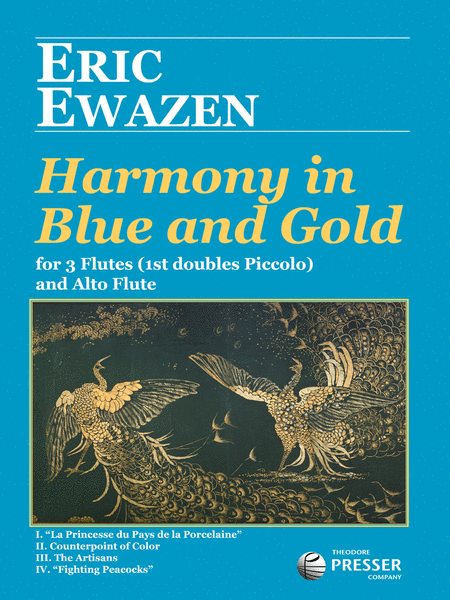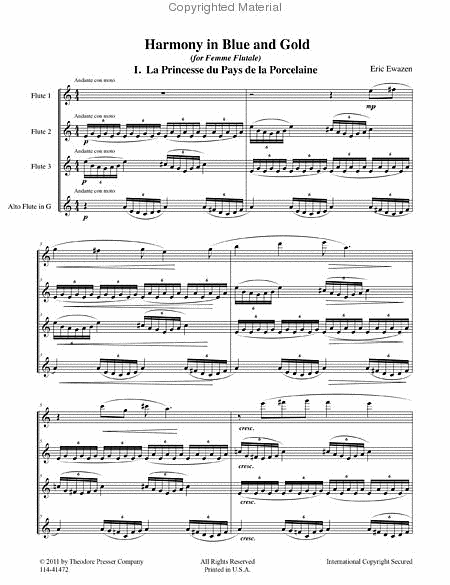Harmony In Blue and Gold
-
Ships in 1 to 2 weeks
Details
Description
SKU: PR.114414720
Composed by Eric Ewazen. Folder. Contemporary. Set of Score and Parts. With Standard notation. Composed 2008. 36+12+12+12+12 pages. Duration 21 minutes. Theodore Presser Company #114-41472. Published by Theodore Presser Company (PR.114414720).ISBN 9781598064254. UPC: 680160598229. 9x12 inches.
Ewazen’s monumental flute quartet was composed for Femme Flutale and premiered at the 2008 Mid-Atlantic Flute Fair. Its four movements were inspired by James McNeill Whistler’s “Peacock Room” at the Smithsonian Institution’s Freer Gallery – a room full of paintings featuring peacocks, and interior design showcasing blue and white porcelain, an integrated room that Whistler called “Harmony in Blue and Gold.” Ewazen’s ornate textures and impressionist moods express this unique environment through his musical world of sounds and lines. Duration: 21’.
PROGRAM NOTESHarmony in Blue and Gold was commissioned and premiered by my friends in Femme Flutale (Laura Benning, Joan da Silva Heit, Nancy Mulholland, and Jill Thomassen), an extraordinary flute quartet based in the Washington DC area. I wanted to write a piece showcasing both their beautiful sound and their amazing virtuosity.Located on the Mall in Washington DC, and a part of the Smithsonian Institution, is the extraordinary Freer Gallery of Art, specializing in Egyptian, Asian, and American Art. Located within is a masterpiece created by James McNeill Whistler — a completely reinstalled room from an English home, full of Victorian splendor, designed to feature original paintings by Whistler as well as the porcelain collection of the gentleman who commissioned this room for his London mansion, Frederick R. Leyland.Whistler titled his design of the room “Harmony in Blue and Gold,” but it is more commonly known as the “Peacock Room,” with its depictions of these spectacular birds in various paintingsthroughout the room. Before it was completed, Leyland and Whistler became embroiled in a dispute over the design of the room, over Whistler’s pandering to the press about the room he was creating, and over the fee that Whistler was to be paid. Slyly, Whistler created one final painting of fighting peacocks, one majestic and dapper, with a silver crest feather, representing Whistler and his own lock of white hair he wore curled above his forehead, and the other peacock, ruffled and angry with coins scattered at its feet and silver feathers around its throat, representing Leland and the ruffled shirts he often wore. To underscore the meaning, Whistler titled this painting “Art andMoney; or, the Story of the Room”! My flute quartet Harmony in Blue and Gold represents this entire room.The first movement, “La Princesse du Pays de la Porcelaine,” or “Princess from the Land of Porcelain,” is a painting of an elegant, beautiful Chinese princess in traditional garb. The musicreflects her calm demeanor and the Asian-influenced art of the Impressionist composers and Impressionist painters who were so inspired by the arts of the East. She reigns over this spectacularroom with quiet dignity, and the music is both gentle and grand.The second movement, “Counterpoint of Color,” represents the excitement one feels viewing this room, with its vivid palette of colors of blue and gold, its intricate complexity of the paintingsoffsetting the elaborate shelves containing detailed white and blue porcelain, and its spectacular gold-coffered ceiling and embossed leather walls. The music spins and dances as one’s eyes takein this sumptuous, colorful room.The third movement, “The Artisans,” reflects the careful craft necessary in creating a beautiful work of art – the music serious but loving, gentle and careful, yet also full of joy at the sheer act ofcreation, and the joy of producing an enduring and noble work of art.The final movement, “Fighting Peacocks,” depicts the allegorical painting Whistler painted detailing his very real feud with the owner of the room. The music is full of dissonance and loud and noisy bird calls, the fighting quite intense with rapid, spinning gestures.Even though Leyland was furious at Whistler, he obviously also appreciated the spectacular nature of the room Whistler created, not changing a single element of Whistler’s design – even leavingthe “Fighting Peacocks” displayed on the wall. Whistler also knew he had created an enduring work of art, and could take great satisfaction in that. Sure enough, the room endures, saved intact,and inspiring viewers to appreciate the beauty and wildness of the room, as well as inspiring composers to write works about that very room. Yes, Whistler’s art endures!– Eric EwazenMay 2012.


 Share
Share